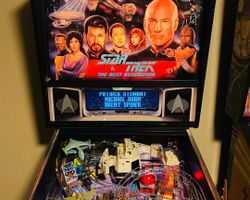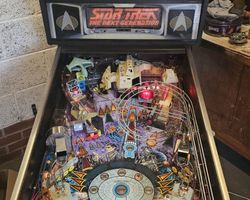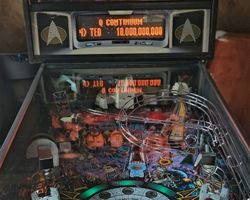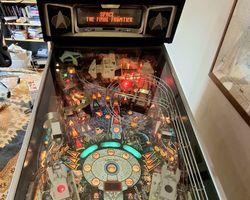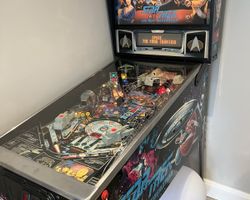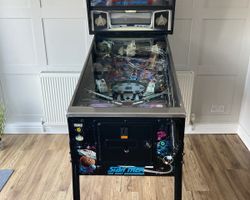Star Trek: The Next Generation
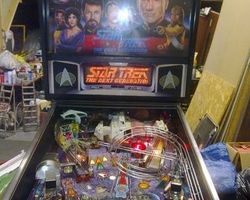
Average Prices: USD $1,200 to $4,100
Produced: November, 1993
Production Run: 11,728 units
Machine Type: Solid State Electronic
MPU: Williams WPC (DCS)
Players: 4
Concept by: Steve Ritchie
Design by: Steve Ritchie, Greg Freres, Dwight Sullivan
Art by: Greg Freres
Dots/Animation by: Scott Slomiany, Eugene Geer
Mechanics by: Carl Biagi
Music by: Dan Forden
Sound by: Dan Forden
Software by: Dwight Sullivan, Matt Coriale
Manufactured by Williams and released in November 1993, the Star Trek: The Next Generation pinball machine boldly took players where no pinball game had gone before. A widebody design, this machine captured the essence of the beloved science fiction television series, immersing players in a universe of exploration, diplomacy, and thrilling space battles. Conceived during the peak of the show's popularity, this pinball game sought to translate the narrative depth and futuristic appeal of Star Trek: The Next Generation into an engaging and challenging play experience.
History and Background
The genesis of the Star Trek: The Next Generation pinball machine was driven by a vision to merge the rich thematic elements of the television series with innovative pinball design. Steve Ritchie, the design mind behind this table, conceptualized a game that would evoke the adventures of Captain Picard and the crew of the USS Enterprise-D. However, securing the license from Paramount Pictures was not without its challenges. Ritchie aimed to incorporate space battles and dynamic action, a concept that initially met with resistance from Paramount, who were protective of the Star Trek image. Ultimately, Ritchie's persuasive vision prevailed, paving the way for a pinball machine that would become a cornerstone of the 1990s pinball era.
The development team assembled to bring this vision to life included notable figures in pinball design. Greg Freres contributed the artwork, crafting visuals that captured the spirit of the series, while Dan Forden composed the music and sound effects, incorporating iconic themes and sounds from the show. Dwight Sullivan and Matt Coriale handled the software, programming the complex rules and modes that defined the gameplay. Carl Biagi engineered the mechanics, ensuring the physical elements of the game functioned seamlessly. Eugene Geer and Scott Slomiany created the animations for the dot matrix display, enhancing the visual storytelling.
Production of Star Trek: The Next Generation commenced in November 1993, with a confirmed run of 11,728 units. Prior to the full production release, approximately 200 prototype models were manufactured for testing. These prototypes, distinguishable by silkscreened backbox side art, domed red lenses on the gun turrets, and more powerful flipper coils, represent a unique piece of pinball history, offering a glimpse into the game's evolution. The game quickly made its mark, becoming a sought-after title in arcades and homes, contributing to the continued success of Williams' "SuperPin" line of widebody games. Its release cemented the Star Trek: The Next Generation pinball machine as a significant title, blending a popular license with innovative pinball engineering.
Signature Features and Design
Several standout features define the Star Trek: The Next Generation pinball machine, elevating it beyond typical games of its time. The most immediately noticeable are the two ball-firing cannons positioned above the slingshots. These cannons, controlled by buttons on the cabinet, offer an alternative method of launching pinballs, allowing players to directly target shots across the playfield, adding a layer of skill and interaction rarely seen in pinball games. This feature encourages players to develop aiming skills beyond the standard flipper control, opening up new strategic possibilities.
Another striking element is the Borg ship suspended above the playfield. This physical toy is not merely decorative; it plays a crucial role in multiball modes. During gameplay, balls can be locked into the Borg ship via the upper-left ramp. When multiball is initiated, the Borg ship dramatically releases the locked ball, firing it directly at the flippers at high speed, creating an exciting and challenging multiball start. This dynamic element visually and mechanically reinforces the theme of confronting the formidable Borg.
A less visible, yet equally significant innovation is the patented below-the-playfield ball delivery system. Designed to maintain a rapid pace of play, this system addresses the potential delays associated with cellar holes – areas on the playfield that capture balls and feed them to mechanisms beneath the playfield. The system pre-positions balls in each of the three under-playfield Vertical Up Kickers (VUKs). When a ball enters a cellar hole, a VUK immediately propels a waiting ball back into play, while the newly captured ball descends to take its place. This ingenious mechanism minimizes downtime and ensures continuous, fast-paced gameplay, a critical aspect of the game’s engaging flow.
Playfield and Mechanics
The playfield of Star Trek: The Next Generation is a meticulously designed landscape of ramps, targets, and interactive elements, laid out to facilitate a dynamic and immersive pinball experience. It features a three-flipper configuration, a classic Steve Ritchie design element, providing players with extensive control over ball trajectory and shot selection. Three ramps – a left ramp feeding to the Borg ship, a central ramp, and a distinctive spiraling wireform ramp originating from the automatic plunger – offer satisfying and challenging shot opportunities.
Key playfield features include three pop bumpers strategically placed to create chaotic ball motion, enhancing the unpredictable nature of pinball. Two sets of three-bank standup targets and a spinning target provide opportunities for targeted shots and scoring objectives. Four cellar holes, one partially obscured by a drop target, add an element of risk and reward. Successfully navigating the cellar holes triggers the rapid ball delivery system and contributes to game progression. A left outlane kickback mechanism offers a degree of forgiveness, rescuing balls from an otherwise draining fate.
The playfield artwork by Greg Freres complements the game's theme, depicting scenes and characters from Star Trek: The Next Generation. The color palette and illustrations evoke the futuristic aesthetic of the show, though some opinions within the pinball community find the artwork less visually striking compared to other games of the era. Lighting is integrated to highlight key playfield features and emphasize game modes, creating a visually engaging environment. The overall aesthetic aims to immerse players in the Star Trek universe, blending artwork, lighting, and sound to create a cohesive and thematic pinball experience.
Gameplay Dynamics
Gameplay in Star Trek: The Next Generation is structured around a mission-based system, mirroring the episodic nature of the television series. Players embark on various "missions," each with unique objectives and scoring opportunities. Completing missions advances game progression and unlocks increasingly challenging modes. This mission structure provides a sense of narrative progression and encourages strategic play, moving beyond simple score accumulation.
Multiball is a central component of the gameplay, with the potential for up to six balls in play simultaneously. Multiple paths to multiball, including locking balls in the Borg ship and achieving specific shot combinations, provide varied gameplay objectives. The six-ball multiball mode, in particular, is a highly sought-after and chaotic experience, offering significant scoring potential and intense action.
A notable gameplay mode is the "Picard Maneuver," a challenging shot that involves skillful flipper control to achieve. Successfully executing the Picard Maneuver is often rewarded with substantial points and game progression, becoming a badge of honor for skilled players. The game also features a video mode, where players pilot a shuttlecraft through a tunnel system, dodging mines and collecting bonuses, adding a classic arcade-style diversion to the pinball experience. A secret video mode, "Riker's Poker Night," provides an additional hidden gameplay element for dedicated players to discover.
The scoring system is designed to reward skillful play and mission completion. Achieving combos, completing missions efficiently, and mastering the cannons contribute to high scores. The game's depth and variety of modes ensure replayability, encouraging players to explore different strategies and master the numerous challenges the game presents.
Reception and Legacy
Star Trek: The Next Generation pinball machine has garnered overwhelmingly positive reception within the pinball community. Praised for its deep rule set, engaging gameplay, and strong thematic integration, it is frequently cited as one of the best pinball machines of the 1990s and a standout title in the Williams WPC era. Players consistently commend the game for its smooth flow, challenging shots, and the satisfying integration of the Star Trek theme, enhanced by custom speech from the original cast and music from the series.
However, some criticisms have been voiced. A recurring point of contention is the playfield artwork, which some find less visually appealing compared to other pinball machines. The outlanes are also noted as being unforgiving by some players, potentially leading to frustratingly quick ball drains, especially for less experienced players. Maintenance is another factor, with some reporting that the machine can require significant upkeep to ensure optimal performance.
Despite these minor criticisms, the legacy of Star Trek: The Next Generation pinball is firmly established as a classic. Its innovative features, such as the cannons and rapid ball delivery system, alongside its deep and engaging gameplay, have solidified its place in pinball history. The game's wide appeal, stemming from both its pinball design and the enduring popularity of the Star Trek franchise, ensures its continued appreciation by collectors and players alike. It remains a sought-after machine, representing a high point in licensed pinball games and a testament to the enduring appeal of both pinball and Star Trek.
Sponsored Links
 Ebay Listings
Ebay Listings
 Auction Results
Auction Results
| Cost | Location | Date |
|---|---|---|
| USD $5,600 |  Utah, United States Utah, United States |
19 November, 2025 |
| USD $4,900 |  Pennsylvania, United States Pennsylvania, United States |
04 November, 2025 |
| USD $4,750 |  Pennsylvania, United States Pennsylvania, United States |
24 October, 2025 |
| GBP £3,883 |  Annesley, United Kingdom Annesley, United Kingdom |
21 October, 2025 |
| GBP £3,271 |  Kenilworth, United Kingdom Kenilworth, United Kingdom |
13 October, 2025 |
| USD $5,100 |  Minnesota, United States Minnesota, United States |
11 October, 2025 |
| GBP £3,000 |  Kirby, United Kingdom Kirby, United Kingdom |
26 September, 2025 |
| GBP £4,086 |  Abingdon, United Kingdom Abingdon, United Kingdom |
25 September, 2025 |
| GBP £4,087 |  Saint Leonards, United Kingdom Saint Leonards, United Kingdom |
25 September, 2025 |
| GBP £4,587 |  Walsall, United Kingdom Walsall, United Kingdom |
25 September, 2025 |


Private Policy · Search Website · Contact Us
As an eBay Partner, we may earn a commission from qualifying purchases made through links on this site, at no additional cost to you.
All trademarks and copyrighted materials remain property of their respective owners. All other content copyright 2007 - 2025 Pinpedia.

